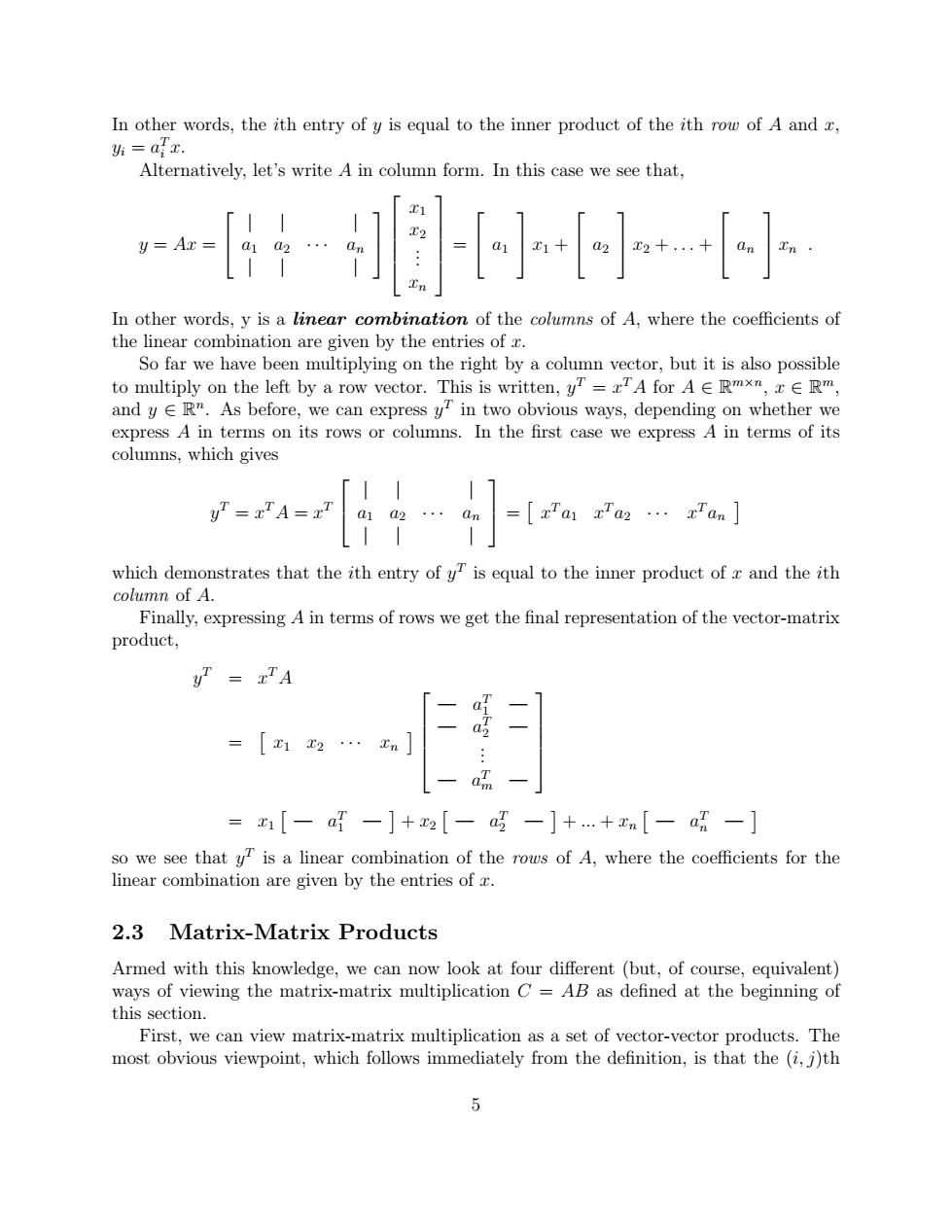正在加载图片...

In other words,the ith entry of y is equal to the inner product of the ith row of A and x, 头=ax. Alternatively,let's write A in column form.In this case we see that, =Ax= 小小小小 In other words,y is a linear combination of the columns of A,where the coefficients of the linear combination are given by the entries of z. So far we have been multiplying on the right by a column vector,but it is also possible to multiply on the left by a row vector.This is written,yT=TA for A ERmxn,e Rm, and y ER".As before,we can express yf in two obvious ways,depending on whether we express A in terms on its rows or columns.In the first case we express A in terms of its columns,which gives yT=TA=2T which demonstrates that the ith entry of y is equal to the inner product of x and the ith column of A. Finally,expressing A in terms of rows we get the final representation of the vector-matrix product, y=xTA =[12 品 =1[-a-]+2[-a3-]+.+xn[-a7-] so we see that y is a linear combination of the rows of A,where the coefficients for the linear combination are given by the entries of r. 2.3 Matrix-Matrix Products Armed with this knowledge,we can now look at four different (but,of course,equivalent) ways of viewing the matrix-matrix multiplication C AB as defined at the beginning of this section. First,we can view matrix-matrix multiplication as a set of vector-vector products.The most obvious viewpoint,which follows immediately from the definition,is that the (i,j)th 5In other words, the ith entry of y is equal to the inner product of the ith row of A and x, yi = a T i x. Alternatively, let’s write A in column form. In this case we see that, y = Ax = | | | a1 a2 · · · an | | | x1 x2 . . . xn = a1 x1 + a2 x2 + . . . + an xn . In other words, y is a linear combination of the columns of A, where the coefficients of the linear combination are given by the entries of x. So far we have been multiplying on the right by a column vector, but it is also possible to multiply on the left by a row vector. This is written, y T = x TA for A ∈ R m×n , x ∈ R m, and y ∈ R n . As before, we can express y T in two obvious ways, depending on whether we express A in terms on its rows or columns. In the first case we express A in terms of its columns, which gives y T = x TA = x T | | | a1 a2 · · · an | | | = x T a1 x T a2 · · · x T an which demonstrates that the ith entry of y T is equal to the inner product of x and the ith column of A. Finally, expressing A in terms of rows we get the final representation of the vector-matrix product, y T = x TA = x1 x2 · · · xn — a T 1 — — a T 2 — . . . — a T m — = x1 — a T 1 — + x2 — a T 2 — + ... + xn — a T n — so we see that y T is a linear combination of the rows of A, where the coefficients for the linear combination are given by the entries of x. 2.3 Matrix-Matrix Products Armed with this knowledge, we can now look at four different (but, of course, equivalent) ways of viewing the matrix-matrix multiplication C = AB as defined at the beginning of this section. First, we can view matrix-matrix multiplication as a set of vector-vector products. The most obvious viewpoint, which follows immediately from the definition, is that the (i, j)th 5����������